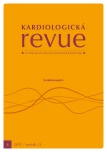Atherosclerosis of the intracranial arteries – current view, 1st part.
Authors:
J. Žižka
Authors‘ workplace:
I. interní klinika, FTNsP/IPVZ, Praha
4
Published in:
Kardiol Rev Int Med 2011, 13(4): 236-240
Overview
Atherosclerosis of the intracranial arteries is a relatively common disease and it is estimated that disease of the intracranial arteries is responsible for c. 8–10% of ischemic stroke in Caucasians. However, it is a much more frequent cause of stroke in Asians, Blacks and Hispanics, and therefore appears to be the most frequent cause of stroke worldwide. For this reason an increasing amount of attention has been paid to this illness worldwide. Risk factors for atherosclerosis of the intracranial arteries are similar to those for atherosclerosis of the extracranial arteries. The prognosis for patients with symptomatic disease of the intracranial arteries is unfavourable, as patients face a high risk of recurrence of cranial episodes, chiefly in the vicinity of the affected artery. Options for treatment are currently limited and results are unsatisfactory – new findings in this area are highly desirable. The following work attempts to give a complex, current view of this illness. The paper is divided into two parts – the second part focuses on diagnosis and treatment.
Keywords:
atherosclerosis – cerebrovascular disease – intracranial stenosis – intracranial occlusion – prognosis – therapy
Sources
1. Školoudík D, Šajerová I, Václavík D et al. Stenózy intrakraniálních tepen – rizikové faktory a riziko cévní mozkové příhody. Čes a Slov Neurol Neurochir 2002; 5: 334–339.
2. Gorelick PB, Wong KS, Bae HJ et al. Large artery intracranial occlusive disease: a large worldwide burden but a relatively neglected frontier. Stroke 2008; 39: 2396–2399.
3. Wong LKS. Global burden of intracranial atherosclerosis. Int J Stroke 2006; 1: 158–159.
4. White H, Boden-Albala B, Wang C et al. Ischemic stroke subtype incidence among whites, blacks, and Hispanics: the Northern Manhattan Study. Circulation 2005; 111: 1327–1331.
5. Arenillas JF, Molina CA, Chacón P et al. High lipoprotein (a), diabetes and the extent of symptomatic intracranial atherosclerosis. Neurolgy 2004; 63: 27–32.
6. Mazighi M, Labreuche J, Gongora-Rivera F et al. Autopsy prevalence of intracranial atherosclerosis in patients with fatal stroke. Stroke 2008; 39: 1142–1147.
7. Caplan LR. Intracranial Large Artery Occlusive disease. Curr Neurol Neurosci Rep 2008; 8: 177–181.
8. Arenillas JF. Intracranial Atherosclerosis. Current Concepts. Stroke 2011; 42 (Suppl 1): S20–S23.
9. Chimowitz MI, Lynn MJ, Howlett-Smith H et al. Warfarin-Aspirin Symptomatic Intracranial Disease Trial Investigators. Comparison of Warfarin and Aspirin for Symptomatic Intracranial Arterial Stenosis. N Engl J Med 2005; 352: 1305–1316.
10. Kang SY, Kim JS. Anterior cerebral artery infarction: stroke mechanism and clinical-imaging study in 100 patients. Neurolgy 2008; 70: 2386–2393.
11. Caplan LR, Wityk RJ, Glass TA et al. New England Medical Center Posterior Circulation Registry. Ann Neurol 2004; 56: 389–398.
12. Caplan LR, Wityk RJ, Pazdera L et al. New England Medical Center Posterior Circulation Stroke Registry. II Vascular Lesions. J Clin Neurol 2005; 1: 31–49.
13. Shin HK, Yoo KM, Chang HM et al. Bilateral intracranial vertebral artery disease in the New England Medical Center Posterior Circulation Registry. Arch Neurol 1999; 56: 1353–1358.
14. Turan NT, Makki AA, Tsappidi S et al. WASID Investigators. Risk Factors Associated With Severity and Location of Intracranial Arterial Stenosis. Stroke 2010; 41: 1636–1640.
15. Ingall TJ, Homer D, Baker HL Jr et al. Predictors of intracranial carotid artery atherosclerosis: Duration of cigarette smoking and hypertension are more powerful than serum lipid levels. Arch Neurol 1991; 48: 687–691.
16. Craig DR, Mageuro K, Watridge C et al. Intracranial internal carotid artery stenosis. Stroke 1982; 13: 825–828.
17. Bauer RB, Boulos RS, Meyer JS. Natural history and surgical treatment of occlusive cerebrovascular disease evaluated by serial arteriography. Am J Roentgenol Radium Ther Nucl Med 1968; 104: 1–17.
18. Akins PT, Pilgram TK, Cross DWT 3rd et al. Natural history of stenosis from intracranial atherosclerosis by seriál angiogramy. Stroke 1998; 29: 433–438.
19. Wong KS, Li H, Lam WMW et al. Progression of Middle Cerebral Artery Occlusive Disease and Its Relationship With Further Vascular Events After Stroke. Stroke 2002; 33: 532–536.
20. Schwarze JJ, Babikian V, DeWitt LD et al. Longitudinal monitoring of intracranial arterial stenoses with transcranial Doppler ultrosonography. J Neuroimaging 1994; 4: 182–187.
21. Famakin BM, Chimowitz MI, Lynn MJ et al. WASID Trial Investigators. Causes and Severity of Ischemic Stroke in Patiens With Symptomatic Intracranial Arterial Stenosis. Stroke 2009; 40: 1999–2003.
22. Kasner SE, Chimowitz MI, Lynn MJ et al. Warfarin Aspirin Symptomatic Intracranial Disease Trial Investigators. Predictors of Ischemic Stroke in the Territory of a symptomatic Intracranial Arterial Stenosis. Circulation 2006; 113: 555–563.
23. Kern R, Steinke W, Daffertshofer M et al. Stroke recurrences in patients with symptomatic vs asymptomatic middle cerebral artery disease. Neurology 2005; 65: 859–864.
24. Marzewski DJ, Furlan AJ, St Louis P et al. Intracranial Internal Carotid Artery Stenosis: Longterm Prognosis. Stroke 1982; 13: 821–824.
25. Huang HW, Guo MH, Lin RJ et al. Prevalence and risk factors of middle cerebral artery stenosis in asymptomatic resident in Rongqi County, Guangdong. Cerebrovasc Dis 2007; 24: 111–115.
26. Bae HJ, Lee J, Park JM et al. Risk factors of intracranial atherosclerosis among asymptomatics. Cerebrovasc Dis 2007; 24: 355–360.
27. López-Cancio E, Dorado L, Millán M et al. The population-based Barcelona-Asymptomatic Intracranial Atherosclerosis Study (ASIA): rationale and design. BMC Neurology 2011; 11: 22.
28. Nahab F, Cotsonis G, Lynn M et al. WASID Study Group. Prevalence and prognosis of coexistent asymptomatic intracranial stenosis. Stroke 2008; 39: 1039–1041.
Labels
Paediatric cardiology Internal medicine Cardiac surgery CardiologyArticle was published in
Cardiology Review

2011 Issue 4
Most read in this issue
- There’s no hypertrophy like hypertrophy, or don’t forget amyloidosis
- Pericardial calcification
- Non-sarcomeric hypertrophic cardiomyopathies in adults
- Peripartum cardiomyopathy
